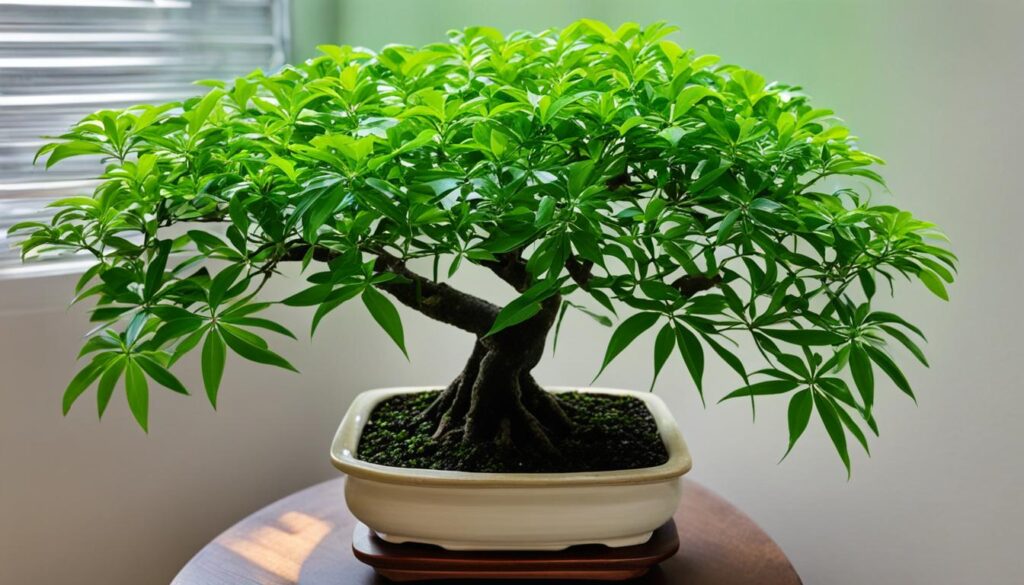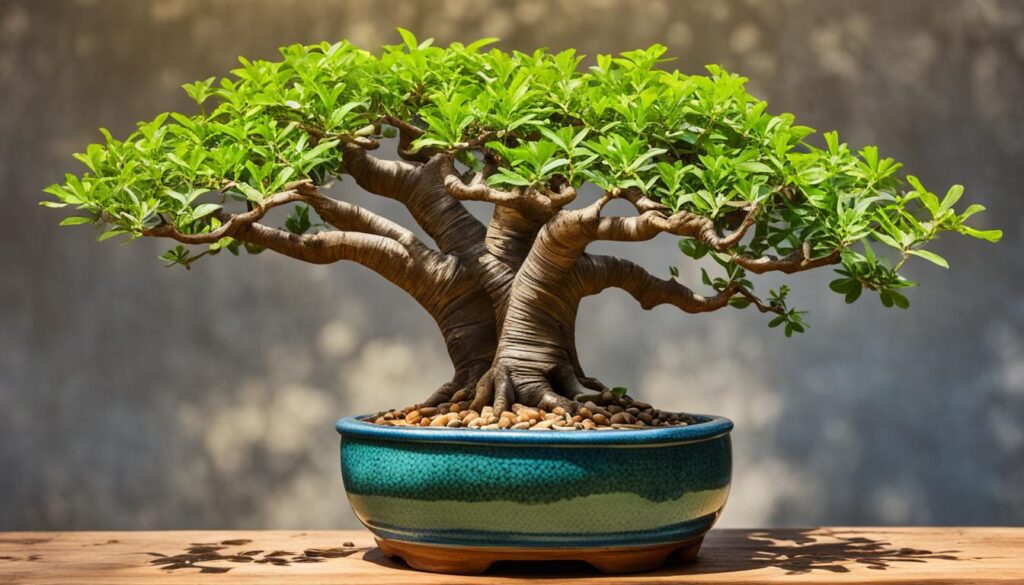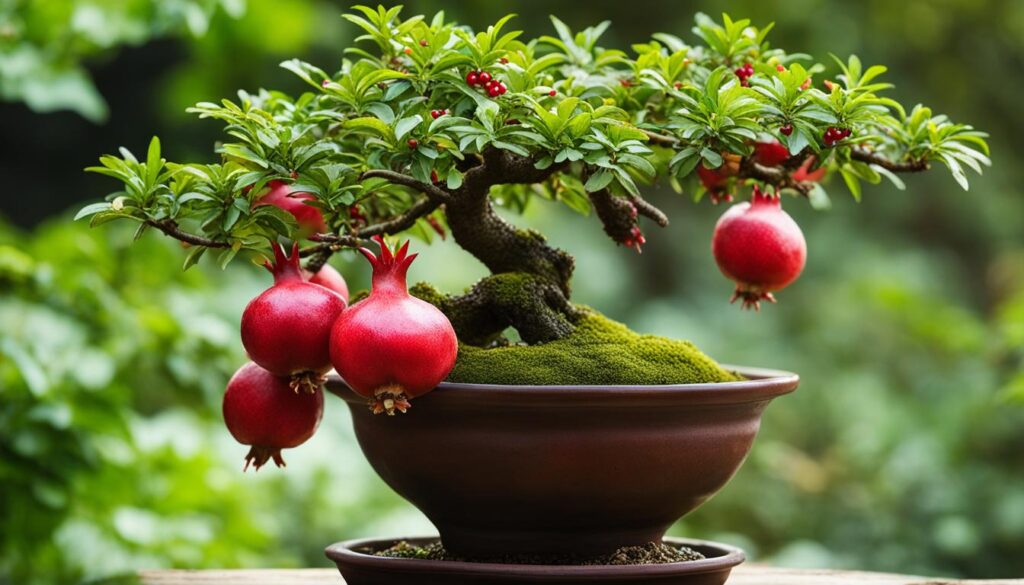Welcome to our comprehensive guide on growing and caring for Schefflera arboricola bonsai, your ultimate source of information on this captivating indoor bonsai tree. Whether you’re a beginner bonsai enthusiast or an experienced gardener looking to add a tropical touch to your collection, this guide has everything you need to ensure the success and beauty of your schefflera bonsai tree.
Plant care is the foundation of a thriving bonsai, and we’ll walk you through every aspect. From pruning techniques and bonsai styling to creating the ideal environment and choosing the perfect bonsai soil mix, we’ve got you covered. Our guide provides expert tips, practical advice, and step-by-step instructions tailored to both beginners and seasoned bonsai enthusiasts.
Discover the unique charm of Schefflera arboricola, also known as the dwarf umbrella tree, and learn how this humble houseplant has become a beloved bonsai species admired for its delicate foliage and graceful appearance. Unlock the secrets to proper watering techniques, feeding requirements, and essential pruning practices for your schefflera bonsai. We’ll also guide you through the propagation and repotting process, as well as how to protect your tree from pesky pests and diseases.
Whether you’re an aspiring bonsai artist or simply seeking the tranquility and beauty of indoor nature, our Schefflera arboricola bonsai guide will empower you to create a stunning tropical oasis right in your own home. Let’s embark on this bonsai journey together, and watch your schefflera bonsai thrive and flourish under your expert care!
Key Takeaways
ToggleIntroduction to Schefflera Arboricola Bonsai
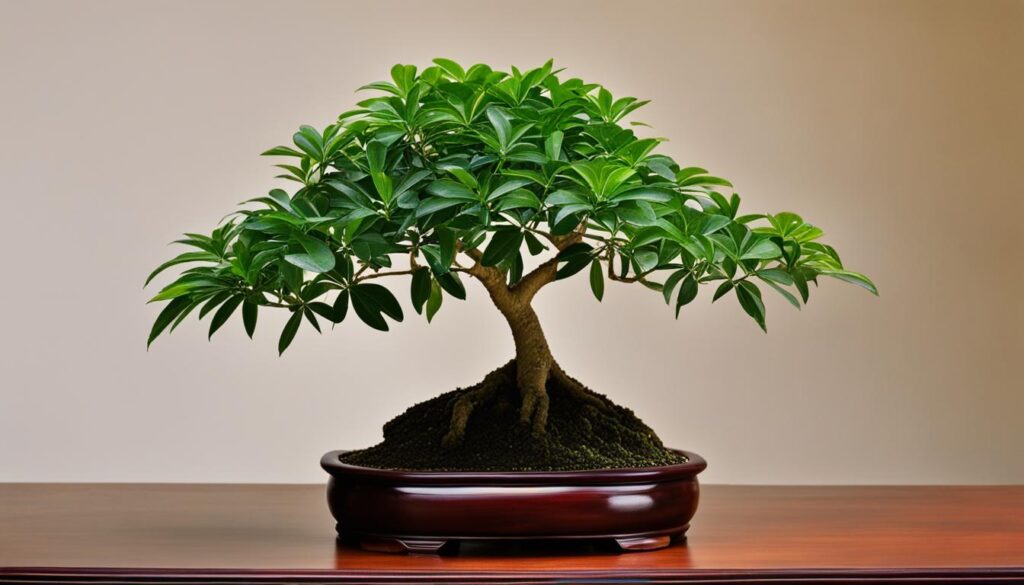
Schefflera arboricola, commonly called the dwarf umbrella tree, is a favored option for indoor bonsai growers. These bonsai trees are miniatures of larger trees, shaped and pruned to create beautiful living art. Schefflera arboricola’s compact size and attractive leaves make it perfect for bonsai cultivation.
This plant originates from the tropical rainforests of Taiwan, thriving as a shrub or small tree. Its vibrant green leaves and fine leaflets add a tropical touch. As an indoor bonsai, Schefflera arboricola can enhance your home with natural beauty and calm.
Caring for Schefflera arboricola bonsai requires creating the right environment for its health and growth. The following sections will detail care needs, methods, and tips to help you nurture a healthy and attractive schefflera arboricola bonsai.
The Unique Charm of Schefflera Arboricola as an Indoor Bonsai

Defining the Dwarf Umbrella Tree
The dwarf umbrella tree, Schefflera arboricola, is a compact and visually captivating bonsai tree. It features slender trunks and branches, giving it an elegant appearance. The leaves of this bonsai species are arranged in a radial pattern, creating a beautiful symmetrical effect.
From Humble Beginnings to Bonsai Beauty
What began as a humble plant has transformed into a bonsai beauty. Schefflera arboricola bonsai showcases grace and delicacy through its intricate foliage and refined form. This indoor bonsai tree effortlessly brings a touch of nature and serenity to any space, making it a favorite among bonsai enthusiasts.
The unique characteristics of Schefflera arboricola bonsai, including its compact size, slender trunks, and radially arranged leaves, contribute to its aesthetic appeal. The delicate foliage and visually pleasing form make it a delightful addition to any indoor bonsai collection.
Creating the Ideal Environment for Your Schefflera Arboricola Bonsai
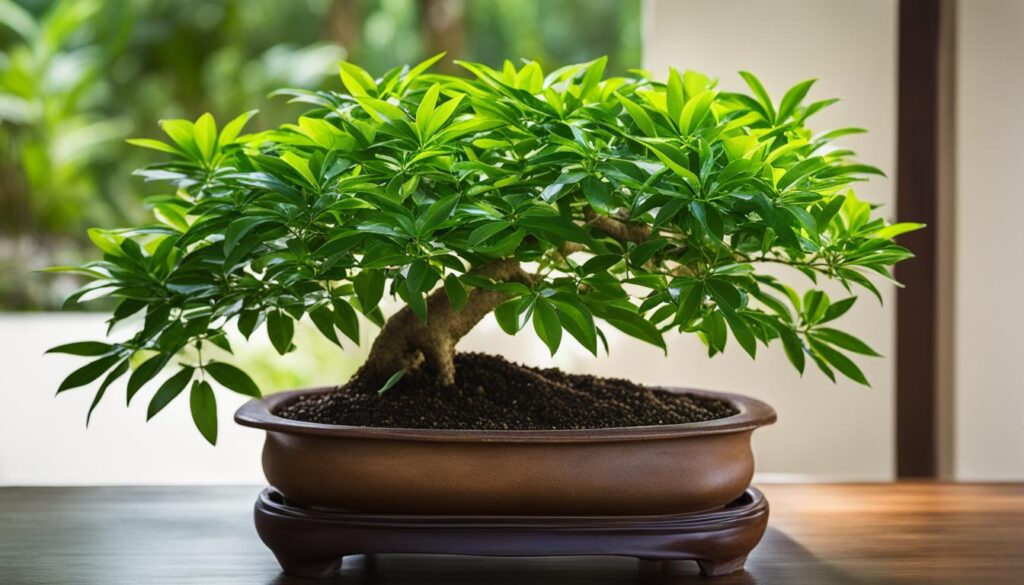
In order for your Schefflera arboricola bonsai to thrive, it is essential to create the perfect environment that meets its specific needs. By understanding the light requirements, as well as the temperature and humidity levels, you can ensure the health, growth, and vitality of your indoor tropical bonsai tree.
Light Requirements for Vigorous Growth
Light is one of the most important factors for the growth and development of your Schefflera arboricola bonsai. This tropical bonsai tree requires bright, indirect light to thrive. Placing it near a window that receives filtered sunlight is ideal. Avoid direct sunlight, as it can scorch the leaves and cause damage to the plant.
If you’re growing your bonsai indoors and don’t have access to sufficient natural light, you can supplement it with artificial grow lights. LED grow lights are a popular choice as they emit the right spectrum of light for healthy bonsai growth.
Temperature and Humidity: Striking the Right Balance
Schefflera arboricola bonsai is native to tropical regions, so it thrives in warm and humid conditions. It is important to maintain a temperature range of 65-85°F (18-29°C) for your indoor bonsai. Avoid exposing it to extreme temperatures, drafts, or sudden temperature changes, as they can cause stress and affect its overall health.
In terms of humidity, Schefflera arboricola bonsai prefers higher levels. You can increase humidity around your bonsai by placing it on a tray filled with water and pebbles. As the water evaporates, it creates a humid microclimate around the bonsai. Alternatively, you can use a humidifier to maintain the desired humidity level.
| Temperature | Humidity |
|---|---|
| 65-85°F (18-29°C) | Higher levels |
By providing the right environment with the proper light, temperature, and humidity, you can ensure the well-being and thriving growth of your Schefflera arboricola bonsai. Remember to monitor these factors regularly and make any necessary adjustments to maintain the optimal conditions for your bonsai’s health and beauty.
Schefflera Arboricola Bonsai Watering Techniques

Proper watering is crucial for the health and survival of your Schefflera arboricola bonsai. By understanding the specific watering techniques for this bonsai tree, you can ensure its optimal growth and vitality.
When watering your Schefflera arboricola bonsai, it’s important to strike the right balance between moist soil and avoiding waterlogging. Overwatering can lead to root rot and other issues, while underwatering can cause the tree to become dehydrated and wilt.
The frequency of watering depends on the season and the specific watering requirements for the environmental conditions. In general, during the warmer months, your bonsai may require more frequent watering due to increased evaporation. However, during the colder months, the watering frequency should be reduced.
To determine when to water your Schefflera arboricola bonsai, observe the soil moisture levels and the appearance of the foliage. The soil should be slightly damp but not overly saturated. If the soil feels dry to the touch, it’s time to water your bonsai.
When watering, thoroughly wet the entire root ball until water starts to drain from the bottom of the pot. This ensures that the roots receive adequate hydration. Avoid using cold or chlorinated water, as they can negatively affect the health of your bonsai. It’s recommended to use room temperature water or let tap water sit for 24 hours to allow chlorine to evaporate.
Remember that different environmental conditions, such as temperature and humidity, can affect the watering needs of your Schefflera arboricola bonsai. Adjust your watering schedule as necessary to meet the specific requirements of your bonsai tree.
Feeding Your Schefflera Bonsai: A Guide to Fertilizing
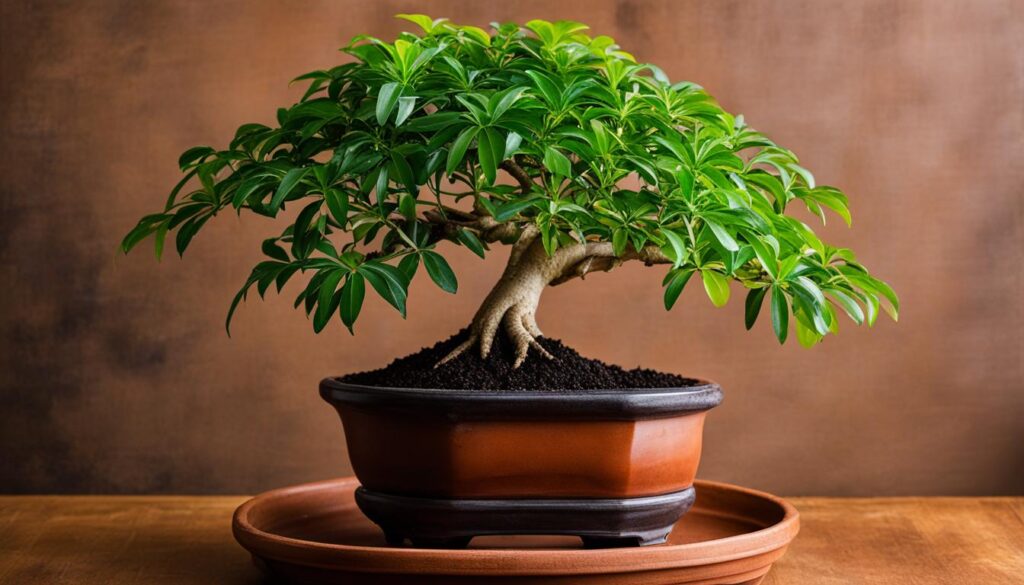
Proper fertilizing is essential to provide the necessary nutrients for your Schefflera arboricola bonsai’s growth and health. Without adequate fertilization, your bonsai may struggle to develop vibrant foliage and maintain its overall vitality.
When it comes to fertilizing your Schefflera arboricola bonsai, it’s crucial to understand the different types of fertilizers that are suitable for its specific needs. A balanced, slow-release fertilizer formulated for indoor bonsai trees is a recommended choice. This type of fertilizer provides a steady supply of nutrients over time, ensuring sustained growth and preventing the risk of nutrient burn.
The dosing instructions for fertilizing your Schefflera bonsai will vary based on the season. During the active growing season, which typically ranges from spring to early fall, you can fertilize your bonsai every two to four weeks. However, during the winter dormant period, it is best to reduce the frequency to once every two months.
To avoid excessive fertilization that can harm your bonsai, always carefully follow the recommended dosage instructions provided by the manufacturer. Overfertilizing can lead to nutrient imbalances, which can negatively impact the health of your bonsai tree.
Creating an optimal feeding schedule is essential to ensure the proper development of your Schefflera arboricola bonsai. It is recommended to fertilize your bonsai after watering, ensuring that the soil is moist but not waterlogged. This will help the nutrients in the fertilizer reach the roots effectively and prevent the risk of root damage.
When fertilizing your Schefflera bonsai, it’s important to avoid common fertilizing mistakes. These include using too much fertilizer, fertilizing during the dormant period, or neglecting to fertilize altogether. By being mindful of these mistakes, you can provide your bonsai with the necessary nutrients it needs for optimal growth and health.
Feeding your Schefflera arboricola bonsai with the right fertilization techniques will result in lush foliage and vibrant growth. By following the guidelines outlined in this section, you can ensure that your bonsai tree thrives and remains a stunning focal point in your indoor garden.
Pruning Techniques and Styling Tips for Schefflera Arboricola Bonsai
Understanding Pruning Basics
Pruning is a vital practice when it comes to maintaining the shape, health, and aesthetics of your Schefflera arboricola bonsai. By selectively removing certain branches and foliage, you can shape your bonsai tree into a visually appealing work of art. Understanding the basics of pruning is essential to achieve optimal results.
When it comes to pruning your Schefflera arboricola bonsai, it’s important to know when and how to make cuts. Start by identifying the branches that need to be removed or trimmed in order to improve the overall structure and balance of the tree. Use clean and sharp pruning tools to make precise cuts, ensuring the health of the tree is not compromised.
By removing overcrowded or crossing branches, you can improve the airflow and light penetration within the canopy. This helps prevent the build-up of moisture and reduces the risk of pest and disease infestation. Pruning also promotes the development of new buds and encourages a more compact growth habit.
Whether you want to create a formal upright style or go for a more informal cascade, pruning plays a crucial role in shaping your Schefflera arboricola bonsai. By selectively removing branches and foliage, you can guide the growth and create a visually pleasing bonsai tree.
Guidelines for Effective Bonsai Styling
Bonsai styling is an art form that takes your Schefflera arboricola bonsai to the next level. Through careful manipulation of branches, foliage, and trunk, you can create a visually appealing and well-balanced bonsai tree.
When styling your bonsai, take into consideration the natural growth patterns and characteristics of the Schefflera arboricola. Aim for asymmetrical balance, capturing the essence of a mature tree while maintaining a miniature size.
Start by analyzing the structure and form of your bonsai tree. Identify the key branches that will form the main structure, and remove any unnecessary or weak branches. Use wiring techniques to shape the branches and create movement and depth within the tree.
Consider the overall composition and ensure that the canopy is balanced and proportionate to the trunk and root system. Prune foliage to create open spaces and allow light to penetrate the inner branches, resulting in a more realistic and natural appearance.
Don’t be afraid to experiment and explore different bonsai styling techniques such as cascade, windswept, or formal upright. Each style can bring a unique charm to your Schefflera arboricola bonsai.
Pruning and styling your Schefflera arboricola bonsai require patience, skill, and an artistic eye. With practice and knowledge of the basics, you can transform your bonsai tree into a stunning masterpiece that captivates and inspires.
Bonsai Soil Mix Essentials for Schefflera Arboricola
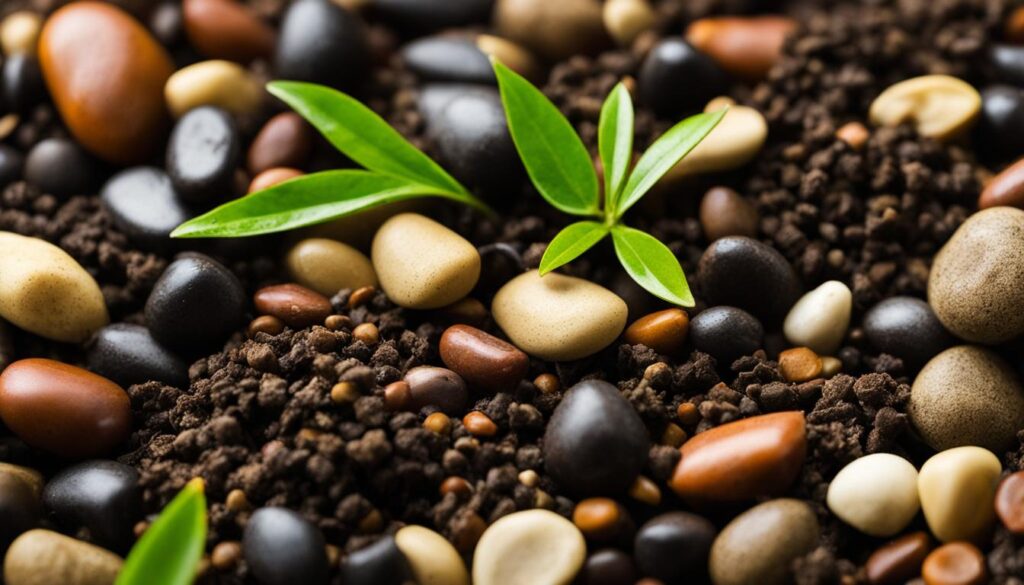
The choice of soil mix is crucial for the health and development of your Schefflera arboricola bonsai. To ensure optimal growth and provide your bonsai tree with the necessary nutrients, it is essential to create the ideal bonsai soil mix.
When creating a bonsai soil mix for your Schefflera arboricola, it is important to prioritize good drainage to prevent waterlogging and root rot. The right blend of components will also promote healthy root growth and nutrient uptake. Here are the key essentials for a balanced bonsai soil mix:
- Organic matter: Incorporate organic materials like peat moss or compost to improve soil fertility and water retention.
- Inorganic components: Add components such as grit, perlite, or pumice to enhance drainage and prevent compaction.
- Bonsai-specific soil mix: Consider using a pre-made bonsai soil mix that is specifically formulated for tropical bonsai trees like Schefflera arboricola.
It is essential to find the right balance between water retention and drainage. A well-draining bonsai soil mix allows excess water to escape easily, preventing waterlogged roots. At the same time, it should retain enough moisture to keep the roots hydrated.
Preparing and maintaining the bonsai soil mix also requires periodic attention. Regularly check the moisture levels and adjust watering frequency accordingly. It is recommended to repot your Schefflera arboricola bonsai every two to three years to refresh the soil and ensure optimum root health.
By providing your Schefflera arboricola bonsai with a well-balanced bonsai soil mix, you are setting the foundation for its overall health and growth.
Propagating and Repotting Your Schefflera Bonsai

Schefflera Bonsai Propagation Techniques
If you want to expand your collection of Schefflera arboricola bonsai, propagation techniques provide an excellent way to do so. There are two common methods of propagating your bonsai: seed propagation and cuttings. Seed propagation involves sowing seeds and nurturing them until they develop into saplings. Cuttings, on the other hand, involve taking a stem or leaf cutting from an existing bonsai and encouraging it to form roots.
To propagate bonsai from seed, follow these steps:
- Soak the seeds in warm water for 12-24 hours to improve germination.
- Fill a seed tray or small pots with a well-draining bonsai soil mix.
- Plant the seeds and cover them with a thin layer of soil.
- Keep the soil consistently moist and place the tray or pots in a warm, humid environment.
- Once the seedlings have developed a strong root system, they can be transplanted into individual bonsai pots.
When propagating bonsai from cuttings, follow these steps:
- Select a healthy stem or leaf cutting from your Schefflera arboricola bonsai.
- Prepare a pot with well-draining bonsai soil.
- Dip the cut end of the stem or leaf into rooting hormone powder to encourage root development.
- Insert the cutting into the soil, making sure it is secured in an upright position.
- Place the pot in a warm and humid location with indirect sunlight.
- Maintain the soil moisture and mist the cutting regularly to maintain humidity.
- After a few weeks, you should start to see root development. At this point, you can transplant the cutting into a bonsai pot.
Best Practices for Repotting
As your Schefflera arboricola bonsai grows, it will eventually need to be repotted to provide fresh soil and promote healthy root growth. Here are some best practices to follow when repotting your bonsai:
- Timing: The best time to repot your Schefflera arboricola bonsai is in early spring, before the growth season begins.
- Choosing the right pot: Select a pot that is slightly larger than the current one, ensuring there is enough room for root development.
- Removing the bonsai from the pot: Carefully remove the bonsai from its current pot, gently loosening the roots to prevent damage.
- Trimming the roots: Trim any excessively long or tangled roots, focusing on maintaining a healthy root system.
- Applying a fresh soil mix: Fill the new pot with a well-draining bonsai soil mix, ensuring the roots are evenly distributed.
- Positioning the bonsai: Place the bonsai in the center of the pot, making sure it is upright and stable.
- Watering and aftercare: After repotting, water the bonsai thoroughly and place it in a shaded location for a few weeks to allow the roots to recover.
Repotting your Schefflera arboricola bonsai at the right time and in the correct manner will ensure its continued growth and health, providing it with a fresh start and the best conditions for thriving.
Protecting Schefflera Arboricola Bonsai from Pests and Diseases
As a proud owner of a Schefflera arboricola bonsai, it’s important to protect your precious tree from pests and diseases. Just like any other plant, bonsai trees are vulnerable to various pests and diseases that can compromise their health and beauty. By understanding the common issues and taking proactive measures, you can ensure the long-term well-being of your indoor tropical bonsai.
One of the key steps in pest and disease prevention is being vigilant of the signs and symptoms. Keep an eye out for any unusual discoloration, wilting, or distortion in the leaves, as these can indicate the presence of pests or diseases. Common pests that may affect your Schefflera arboricola bonsai include spider mites, aphids, and scale insects. Additionally, fungal diseases like root rot and powdery mildew can be problematic.
If you notice any signs of pests or diseases, it’s important to take immediate action. There are various treatment options available, including organic insecticides, horticultural oils, and fungicides. Before applying any treatment, carefully read and follow the instructions on the product label to ensure its safe and effective use. Regularly inspect your bonsai tree and address any issues promptly to prevent the spread and escalation of pests or diseases.
To further protect your Schefflera arboricola bonsai, practice good bonsai hygiene. Clean and sterilize your tools after each use to prevent the transmission of pathogens. Avoid overwatering, as excessive moisture can create an environment conducive to fungal growth. Properly position your bonsai tree to optimize air circulation and reduce the risk of humidity-related issues.

